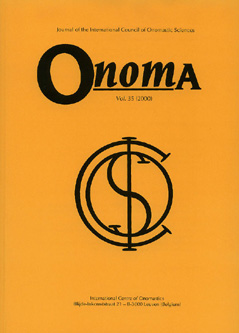 previous article in this issue previous article in this issue | next article in this issue  |

Preview first page |
Document Details : Title: Aspects of the Development of Faeroese Personal Names during 1000 years Subtitle: A Short Overview Author(s): JOHANSSEN, Anfinnur Journal: Onoma Volume: 37 Date: 2002 Pages: 251-266 DOI: 10.2143/ONO.37.0.519195 Abstract : This article reviews the main aspects of the development of Faeroese personal names during a millennium from the Viking Age until today, especially names with Nordic and ecclesiastical provenance. All the Faeroese sources from the time before the Reformation (1535-40) have been excerpted. The Norse settlers, called landnamsmen, brought a Norse name tradition to the Faeroes, but the first generations after Christianity was proclaimed in the 11th century Introduced ecclesiastical names, although Nordic names still held a strong position relative to ecclesiastical names throughout the Middle Ages, i.e. about 75% to 20%. The most important sources on personal names after the Reformation are discussed, and some specific sources are dealt with in detail. By the end of the 16th century ecclesiastical names have gained ground at the expense of Nordic names and until around 1900 c. 80% of the names are ecclesiastical and c. 15% of Nordic origin. The emerging national movement at the end of the 19th century, which led to a growth in national consciousness, led also to an increase in Nordic names, so that the percentage of Nordic and ecclesiastical names among all named children in 2000 is more or less equal. A concurrent reason for this is undoubtedly the fact that the first Act on Personal Names of the heroes came in force in 1992, which included an officially recognised list of names, of which 2/3 are of Nordic origin. The ten most commonly used personal names from specific centuries are also mentioned. |
|


